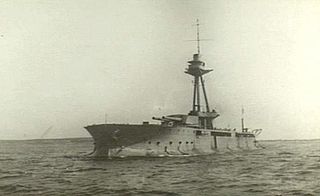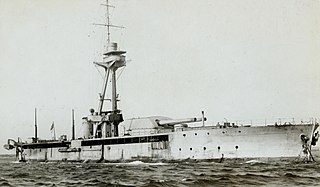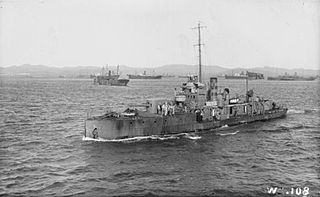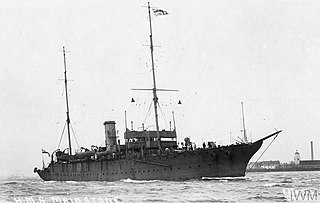
The M29 class comprised five monitors of the Royal Navy, all built and launched during 1915.

HMSM33 is an M29-class monitor of the Royal Navy. Built in 1915, she saw active service in the Mediterranean during the First World War and in Russia during the Allied Intervention in 1919. She was used subsequently as a mine-laying training ship, fuelling hulk, boom defence workshop and floating office, being renamed HMS Minerva and Hulk C23 during her long life. She passed to Hampshire County Council in the 1980s and was then handed over to the National Museum of the Royal Navy in 2014. A programme of conservation was undertaken to enable her to be opened to the public. HMS M33 is located within Portsmouth Historic Dockyard and opened to visitors on 7 August 2015 following a service of dedication. She is one of only three surviving Royal Navy warships of the First World War and the only surviving Allied ship from the Gallipoli Campaign, the other being the Ottoman minelayer Nusret, preserved in Çanakkale.

HMS Raglan was a First World War Royal Navy Abercrombie-class monitor, which was sunk during the Battle of Imbros in January 1918.

HMS Abercrombie was a First World War Royal Navy Abercrombie-class monitor.
HMS Prince Eugene was one of eight Lord Clive-class monitors built for the Royal Navy in 1915 to conduct shore bombardments during the First World War. The ship was assigned to the Dover Patrol for the duration of the war and provided cover for the Inshore Squadron during the First Ostend Raid. She was sold for scrap in 1921.

HMS Mermaid was a Hawthorn Leslie three-funnel, 30 knot destroyer ordered by the Royal Navy under the 1896 – 1897 Naval Estimates. She was launched in 1898, served during World War I and was sold for breaking in 1919.

HMS Cheerful was a 30-knot, three-funnel torpedo boat destroyer built by Hawthorn Leslie. She was ordered by the Royal Navy under the 1896–1897 Naval Estimates, launched in 1898, and saw action during World War I. She was mined off the Shetland Islands in 1917 and sank with the loss of 44 officers and men.
Six ships of the Royal Navy have been named HMS Talbot, probably after John Talbot, 1st Earl of Shrewsbury:
Ten ships of the Royal Navy have borne the name HMS Medusa, after the ancient Greek mythological figure Medusa:

HMS Havelock was an Abercrombie-class monitor of the Royal Navy that saw service in the First World War.

HMS Roberts was an Abercrombie-class monitor of the Royal Navy that served in the First World War.

HMS M30 was a Royal Navy M29-class monitor of the First World War.

HMS M31 was an M29-class monitor of the Royal Navy.
HMS M32 was an M29-class monitor of the Royal Navy.

The M15 class comprised fourteen monitors of the Royal Navy, all built and launched during 1915.
HMS M22 was a First World War Royal Navy M15-class monitor. Later converted to a minelayer and renamed HMS Medea, she was wrecked whilst being towed for breaking up on 2 January 1939.

The SS Cevic was a steam ship built by Harland and Wolff for the White Star Line for service initially in the North Atlantic. Later she was transferred to the Australia run. On the outbreak of the First World War she was sold to the Admiralty and converted to a dummy capital ship. Later she was transferred to the Royal Fleet Auxiliary. After the war she was sold to the Anglo-Saxon Petroleum Company.

HMS Cyclops (F31) was a submarine repair and depot ship of the Royal Navy. She was originally the passenger liner Indrabarah sister ship to Indralema, built by Laing, for the Indra Line Ltd then bought by The Admiralty, while she was building. She was launched on 27 October 1905.

HMS Tyne was a Royal Navy store ship. Charles Mitchell of Low Walker, Newcastle upon Tyne built her as yard number 354, and launched her on 19 January 1878 as the merchant ship Mariotis for the Moss Steam Ship Company of Liverpool. The Admiralty bought her for the Royal Navy on 8 March 1878. She was completed in June 1878.

HMS Maidstone was a submarine depot ship of the Royal Navy. She was purpose built to support 12 of the new 'D' Class submarines under the 1910/11 Naval Programme.














